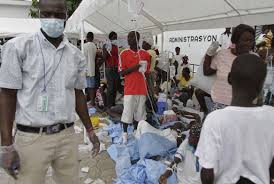Analysis: Haiti's cholera strain came from South Asia

Dec 10, 2010 (CIDRAP News) – In the most detailed analysis to date on the Vibrio cholerae strain that has sparked Haiti's outbreak, researchers confirmed that it most closely resembles a South Asian variant not previously seen in the region and that it is more lethal than other strains.
The researchers, who also compared Haiti's strain with several other known strains, said findings suggest it may have been brought in from a distant source. Their report appeared yesterday in an early online edition of the New England Journal of Medicine (NEJM).
It is the second report this week that suggests that the cholera strain responsible for the epidemic in Haiti, which hasn't had a cholera outbreak in nearly a century, was brought in from a foreign source. Speculation that the disease could have been brought from outside the country has provoked violent protests on top of political unrest surrounding a national presidential election.
Earlier this week an epidemiologist's report commissioned by the French government, which was leaked to the media, said United Nations (UN) peacekeeping forces from Nepal are the likely source. The findings concluded that cholera originated in a tributary of the Artibonite River near a UN base that housed the soldiers. However, Nepalese officials have denied the claims and some disease experts have said the results are inconclusive.
In the genetic profiling study, researchers from Pacific Biosciences of California, a biotechnology company based in Menlo Park, and Harvard University's medical school used a new test, single molecule real-time DNA sequencing, to rapidly characterize the pathogen. Some members of the team recently brought samples back from Haiti, where they had been working alongside Haitian collaborators, according to a press release yesterday from Pacific Biosciences.
Dr Eric Schadt, chief scientific officer of Pacific Biosciences and coauthor of the report, said in the press release that a complete characterization of the pathogen can help guide public health decisions in outbreaks such as Haiti's, such as whether or not vaccines would be useful in slowing the outbreak.
"The ability to quickly and easily perform real-time monitoring of pathogens also opens the door to using this technology as a routine surveillance method, for public health protection in addition to pandemic prevention and response," he said. In the NEJM report, the group wrote that the introduction of the disease through human activity is a reminder that predicting outbreaks requires a global, not just local, assessment of risk factors.
Though investigators didn't pinpoint an exact geographic source, they found that the Haitian cholera isolates closely resembled El Tor O1 strains isolated in Bangladesh in 2002 and 2008 and were more distant from circulating South American strains.
They wrote that their analysis is in line with what the US Centers for Disease Control and Prevention (CDC) has found. "Collectively, our data strongly suggest that the Haitian epidemic began with introduction of a V cholerae strain into Haiti by human activity from a distant geographic source," they said.
Analysis shows that Haiti's strains are distinct from those in Latin America and the US Gulf Coast, making it less likely that cholera arose from Haiti's local aquatic environments, they noted.
Genetic sequencing of the strain in Haiti, similar to South Asian strains, suggests that it is more virulent and is associated with antibiotic resistance, which could pose a threat to other areas in the geographic region that have poor sanitation, the authors wrote.

The CDC today in Morbidity and Mortality Weekly Report (MMWR) also alluded to the virulence of the strain circulating in Haiti. It said the strain appears to be linked to a classic toxin type that is thought be associated with more severe illness. It noted that during a decade-long cholera epidemic in Central and South America that began in 1991, the population—like that of Haiti—had not been exposed to cholera and lacked immunity.
Peru had the epidemic's highest levels of illnesses and deaths. The CDC's comparison of the first 6 weeks of the outbreak in the two countries shows that hospitalizations and deaths were substantially higher in Haiti, where hospitalizations were 393 per 100,000 and deaths were 11.5 per 100,000. Peru's hospitalizations and deaths during the first 6 weeks of its outbreak were 87.5 and 1.7, respectively.
In other developments, global health officials are starting to reconsider the option of a vaccination campaign in Haiti against cholera, based on new information indicating that companies may have more vaccine available than originally thought, National Public Radio (NPR) reported today.
Experts haven't pursued immunization, because they haven't thought there was enough vaccine available to slow the outbreak and feared that a vaccine campaign would detract from disease treatment efforts, NPR reported.
Dr John Andrus, deputy director of the Pan American Health Organization (PAHO), told NPR that PAHO has learned that manufacturers may have more than 1 million doses. "That's new information to us and basically changes our thinking," he said.
Chin CS, Sorenson J, Harris JB, et al. The origin of the Haitian cholera outbreak strain. N Engl J Med 2010 Dec 9; early online edition [Abstract]


Comments
Post a Comment